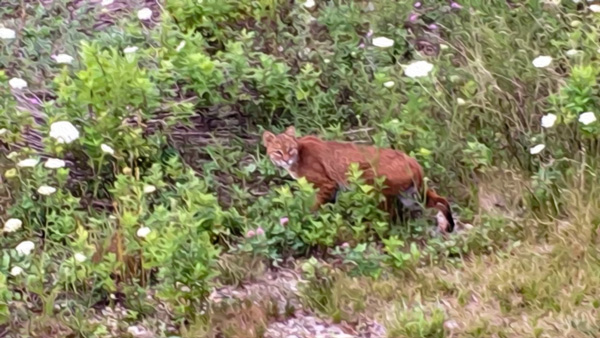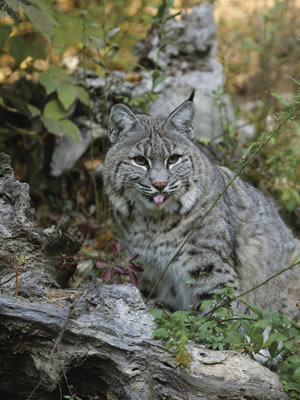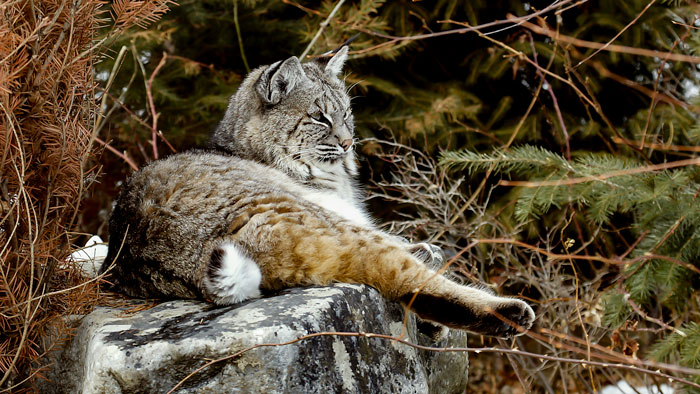Bobcats are one of four species grouped within the Lynx genus. The other three are the Eurasian, Spanish and Canadian lynx. Bobcats share territory with their Canadian cousins only along the US border, and dominate the rest of North America, extending their habitat from forests area to both wetlands and deserts. Endangered in New Jersey, bobcats have gradually reemerged in the state's most remote areas.

The bobcat, carrying a freshly killed rabbit, slipped through some mountain laurel. Almost three feet long and twenty inches high at the shoulder, in good years she might weigh as much as twenty-five pounds. If desperate —or lucky—she could take down a small deer. She needed strong hunting skills; the males left after breeding and she raised her young alone. Most of the food she brought to her kittens consisted of squirrels, rabbits, chipmunks, and mice. Sometimes she caught a wild turkey.
The bobcat worked her way through the vegetation. Her soft tawny coat blended in with her surroundings, but not enough to escape the notice of a young woman exploring a rocky slope near Wildcat Ridge Wildlife Management Area.
Mackenzie Hall, an employee with the Conserve Wildlife Federation of New Jersey, had left the trail in search of timber rattlesnakes. Chatting on a cell phone with her supervisor, Mackenzie saw a small brown shape in the laurel. One hundred feet from the cat, she caught a glimpse of tufted ears, spotted pelt and stumpy tail. Intent on reaching her den, the bobcat did not see the woman ahead. Mackenzie waited, enthralled. When the cat finally sensed Mackenzie's presence, barely thirty feet separated the two. The dam quietly shifted her course and, as if it had learned its tricks under the tutelage of the Cheshire Cat, simply disappeared.
Several years later, the memory of the bobcat still gives Mackenzie a visible thrill. "They're pretty shy animals," she says. "I've spent countless hours in the woods. I've only seen them twice. They're cognizant, camouflaged, and quiet, traits that don't lend themselves to casual encounters."
Mick Valent, Principal Zoologist of the Endangered and Nongame Species Program at the New Jersey Division of Fish and Wildlife, sighs when reminded of Mackenzie's experience. "I've spent so much time out in the field, and I've never seen a bobcat in the wild."

Ironically, the zoologist has dedicated years towards efforts to ensure that bobcats roam New Jersey's forests. From 1978 to 1982, the NJ Department of Environmental Programs brought in twenty-four bobcats from Maine and Massachusetts. In the late 1990s, Mick Valent led a bobcat monitoring program that centered on the movements of individual cats, dispersal, population densities, etc. New tools soon brought in a wealth of data. In 2002-2003 the program began placing satellite collars on trapped bobcats. The program posed its own challenges. They did not appreciate being cornered, so angry bobcats required sedation via spring-loaded syringes at the end of jab poles.
Encounters with trapped bobcats are often revelatory. One of Mackenzie Hall's experiences was no exception. "I was supposed to monitor this one trap," she recalls. "It was Day One at that location. I certainly didn't expect to find anything. When I saw her I felt complete and utter amazement. She was snarling and lunging at me. She was fierce."
The satellite collars, however, proved to be valuable tools that cut down on fieldwork. The collars beamed data to a satellite. The data was then emailed to Mick Valent's team. That particular research process, though productive, did not last. In 2004-2005, the program switched to GPS collars that store data. The batteries die within one year, at which point the signal changes and the collar falls off. The staff heads out to retrieve the collar with its data.
As more data surfaced, Mick and his team came to an important realization. Roads and development seemed to have a major impact on prime areas of bobcat habitat: Kittatinny Ridge and a large tract around West Milford.

Bobcats thrive in habitats that merge open lands and forests. They prefer heavy cover, such as that provided by vines and shrubs, under which they can rest safely, but they hunt everywhere: swamps, bogs, thickets, fields and forests. Rocky parts of northern New Jersey also provide caves in which they often raise their young.
The most remote areas in northern New Jersey offer prime bobcat habitat. Many tracts of land still contain large areas of contiguous forest, and the bobcats introduced almost thirty years ago had apparently settled in. The cat Mackenzie spotted was very likely a descendant of one of those bobcats. This outcome has simultaneously signaled successÑand a cause for concern.
Bobcats are protected under the New Jersey Endangered Species Act. Hunters are not the problem, or not a significant one. Fragmentation, caused by development and traffic, seem to have constrained the local populations, particularly two in northern New Jersey. "To maintain a viable population, we need more gene flow." Mick Valente explains. "We need to learn whether or not there is a breeding interaction between these two populations."

Close breeding can weaken the gene pool, so a healthy population must have access to outsiders. Males can maintain up to twenty-five square miles. The females utilize smaller areas, in part to stay close to their dens. The males and females breed in mid-late February to early April, but otherwise they have few interactions. "We need to keep that gene pool flowing," Mick adds.
The program began to study the impact of roads and the need for wildlife corridors. Collared animals have turned up near roads; the question is, where do they cross? This summer, NJF&W will place cameras near Route 80 in an attempt to learn the answer. If the bobcats can be encouraged to travel, the gene pool will disperse and strengthen.
Personnel engage in other efforts to locate and study the animals; cotton swabs, spritzed with bobcat urine and left on the ground, serve as scent post stations designed to lure in the stealthy creatures, while motion detection cameras record activity at the site. But technology is not the only tool at the division's disposal.
Gretchen Fowles, a Geographic Information Systems Specialist within the Endangered and Non-game Species Program, maps habitat and species locations. She works with complex data systems, but she also works with Bear, a furry, black Chow and Labrador mix that came from Working Dogs for Conservation Foundation in Montana.
She shows pictures of the shaggy black dog sitting by bobcat sign while Gretchen retrieves lumpy brown objects from the snow. The scat will go in for testing that will inform them which individual cat lives in or visits the area. In many photos Bear waits patiently, or appears to happily chew a soft rubber ball.
"He's such a good dog," she says. "He loves his work."
Gretchen and Bear dominate the photo. The only sign of their quarry is a small stain in the snow. But unlike Yeti—or the mountain lion(s) sometimes said to live in northern Jersey—their quarry lives, and it lives in our forests.